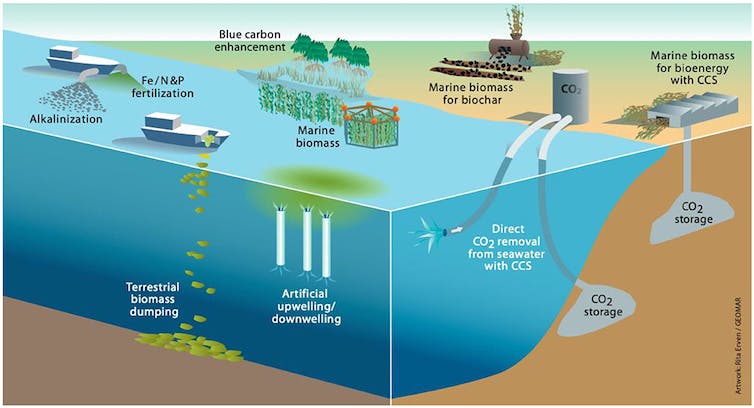Heat waves, droughts and extreme weather are endangering people and ecosystems somewhere in the world almost every day. These extremes are exacerbated by climate change, driven primarily by increasing emissions of greenhouse gases that build up in the atmosphere and trap heat at the Earth’s surface.
With that in mind, researchers are exploring ways to pull carbon dioxide out of the atmosphere and lock it away – including using the ocean. But while these techniques might work, they raise serious technical, social and ethical questions, many of which have no clear answers yet.
We study climate change policy, sustainability and environmental justice. Before people start experimenting with the health of the ocean, there are several key questions to consider.
Ocean carbon dioxide removal 101
The ocean covers about 70% of the planet, and it naturally takes up carbon dioxide. In fact, about a quarter of human-produced carbon dioxide ends up in the ocean.
Ocean carbon dioxide removal is any action designed to use the ocean to remove even more carbon dioxide from the atmosphere than it already does and store it.
It spans a wide range of techniques – from increasing the amount and vitality of carbon dioxide-absorbing mangrove forests to using ocean fertilization to stimulate the growth of phytoplankton that absorb carbon dioxide to building pipelines that pump liquid carbon dioxide into formations under the seabed, where it can eventually solidify as carbonate rock.

Methods of ocean direct carbon removal.
2021 Boettcher, Brent, Buck, Low, McLaren and Mengis, Frontiers, 2021, CC BY
There are other forms of carbon dioxide removal – planting trees, for example. But they require large amounts of land that is needed for other essential uses, such as agriculture.
That’s why interest in using the vast ocean is growing.
Would these methods store enough carbon?
The first crucial question is whether ocean carbon dioxide removal techniques could significantly reduce atmospheric carbon dioxide and store it long term, beyond what the ocean already does. Greenhouse gas emissions are still increasing globally, which means that ocean carbon dioxide removal would need to keep carbon dioxide out of the atmosphere for a long time, at least until greenhouse gas emissions have fallen.
Initial evidence suggests that some forms of ocean carbon dioxide removal, such as those that rely on short-lived biomass like kelp forests or phytoplankton, may not keep captured carbon stored for more than a few decades. That’s because most plant tissues are quickly recycled by decay or by sea creatures grazing on them.
In contrast, mechanisms that form minerals, like the interaction when carbon dioxide is pumped into basalt formations, or that alter the way seawater retains carbon dioxide, such as increasing its alkalinity, prevent carbon from escaping and are much more likely to keep it out of the atmosphere for…



